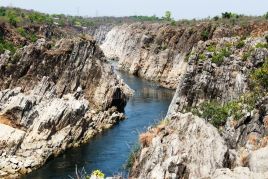
It is a famous tourist destination in Jabalpur district well known for its incredible natural beauty, marble situated on the sides of the Narmada River which flows through the gorge.

Bhedaghat has a famous water falls known as Dhuandhar Falls. Bhedaghat has been added on UNESCO list of natural world heritage sites.
Location:
Bhedaghat is located in Jabalpur district in the state of Madhya Pradesh, India. It is situated by the side of river Narmada and is approximately 20 km from Jabalpur city.
Narmada river is the 5th longest river in India and the longest west-flowing river in the country. It is also the largest flowing river in the state of Madhya Pradesh. It is one of the rivers in India that flows in a rift valley, bordered by the Satpura and Vindhya ranges. The source of the Narmada is a small reservoir, known as the Narmada Kund, located at Amarkantak in the Anuppur District [Madhya Pradesh].
Narmada -Through the veil of myths & beliefs
In Indian subcontinent landscapes and rivers have a sacred linking with mythology. Narmada River is not an exception and which is considered as a goddess as well as a river in Hindu mythology. The Matsya Purana states that all of the banks along the Narmada are sacred.
According to Hindu mythological stories and legends the Narmada was created from Shiva’s perspiration while he was performing penance on Mount Riksha and therefore the Narmada River is considered as Shiva’s daughter.
As per another legend, the river Narmada has a different story of origin. The two teardrops fell from the eyes of Brahma [ the creator of the universe] started flowing as two rivers – the Narmada and the Son River.
The pebbles of Narmada River also speak a story of mythological linking. Narmada Riverbeds’ pebbles are known as banalinga. The pebbles are made up of white quartz and are linga shaped [ Shiv linga]. They are believed to be the personified form of Shiva.
The Narmada River is also worshipped as mother goddess Muktidayani, or liberating mother.
Dhuandhar Falls

The Narmada river descends from Sonmuda, then falls over a cliff as Kapildhara waterfall and meanders in the hills, flowing through a tortuous course crossing the rocks and islands up to the ruined palace of Ramnagar. The river then runs north–west in a narrow loop towards Jabalpur. Close to Jabalpur city , at Bedaghat the river forms Dhuander falls.
This waterfall is located on the Narmada River in Bhedaghat and the fall is 30 meters high. Dhuandhar waterfalls can be accessed from the east bank as well as the west bank of the Narmada River.
The Narmada River, making its way through the world-famous Marble Rocks, narrows down and then plunges into a waterfall known as Dhuandhar. The plunge creates a bouncing mass of mist. The waterfall creates a smoky atmosphere and hence it is known as Dhuander fall. The word ‘Dhuandhar’ is derived from two Hindi words Dhuan which means smoke and Dhar meaning flow.
This huge waterfall can be heard from a far distance as water plunges with intense force.
To view the other side of Dhuandhar Falls, cable car service is available at Bhedaghat. The ropeway facility starts from the east bank of the Narmada River, crosses the river and then drops tourists off at the river’s west bank
Bhedaghat a favourite shooting location for Hindi movie makers
Many famous and superhit movies have been shot in this hilly terrain.
The Hindi film Asoka was shot in Bhedaghat among the marble rocks by the Narmada River [2001].
The crocodile fight scenes of the Hindi film Mohenjo Daro also are shot at Bhedaghat[2016].
How to reach Bhedaghat?
The nearest railway station is Bhedaghat Railway station. It is possible to take a tempo (auto-rickshaw) from Jabalpur to Bhedaghat. Its distance from the main city is about 28 km. The nearest airport is Jabalpur.
References



